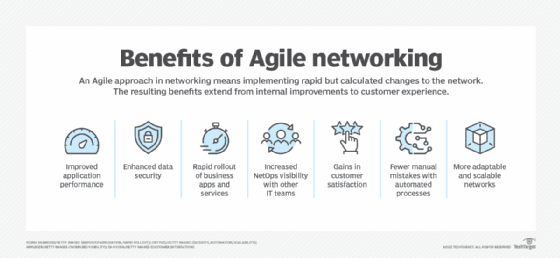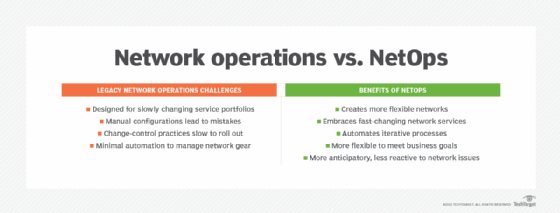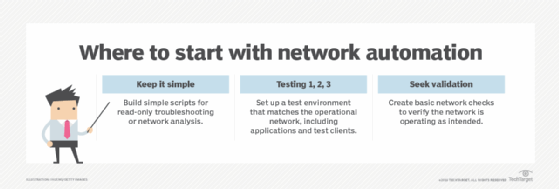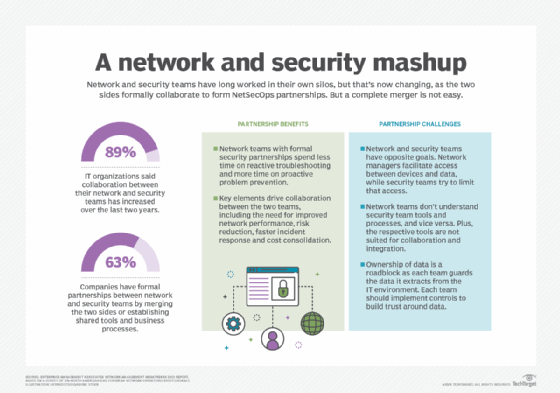What is NetOps? Everything you need to know
NetOps, also referred to as NetOps 2.0 or NetDevOps, is an approach to networking operations that uses DevOps tools and techniques to make network changes more efficiently and effectively than in the past.
NetOps was once an abbreviation for traditional network operations, which often resulted in inflexible, complex and static infrastructure. NetOps today has been reimagined to enable agile, scalable and programmable networks that support faster software development cycles, according to John Burke, CIO and principal research analyst at Nemertes Research.
Borrowing from DevOps methodology, NetOps incorporates automation and continuous integration and continuous delivery (CI/CD ) to streamline operations. In treating infrastructure as code (IaC) NetOps 2.0 represents a major paradigm shift. Historically, network teams have managed enterprise networks manually using command-line interface (CLI) scripting, with the emphasis on availability and uptime rather than flexibility. As a result, network management lagged behind application development, which slowed digital transformation.
NetOps 2.0 aims to bring the network up to speed, but its adoption remains a work in progress for many organizations.
Why is NetOps important?
The NetOps 2.0 transformation is taking place because digital enterprises need their networks to deliver applications and services faster. The goal is to address legacy networks' limitations by making them more responsive and flexible.
Using network automation, orchestration and virtualization, NetOps can help an enterprise respond quickly and consistently to new requests and events while minimizing manual intervention. A move to an Agile networking approach has clear business benefits, from faster service delivery to enhanced data security, according to networking expert Andrew Froehlich, president of West Gate Networks.
Network teams are being asked to deliver more capabilities faster to distributed users, often without increases in networking staff. To deal with the growing workload, NetOps teams can create a proactive, programmable network that better supports digital transformation while also managing hybrid environments with public and private cloud connections. With NetOps, network teams expect frequent changes and try to minimize potential side effects of those changes rather than avoid them entirely.

Benefits of a NetOps approach
Just as DevOps creates a continuous software development framework, a NetOps model takes the same approach for rapid application deployments, according to Froehlich. The three pillars of NetOps 2.0 -- network virtualization, network automation and AI-backed network monitoring tools -- help networking teams run modern networks, which extend beyond on-premises networks to virtual networks within public and private clouds, he added.
Some benefits of NetOps include the following:
- Faster provisioning and deployment. Network virtualization enables NetOps teams to provision and deploy network devices more quickly because routers, switches and network security don't need to be deployed as physical hardware within the network infrastructure.
- Continuous improvement. Network automation supports new applications and services deployed with continuous improvement in mind.
- Proactive remediation. AI network monitoring tools help NetOps teams more proactively identify and remediate network performance and security issues.
- Easier troubleshooting. The use of AI for IT operations (AIOps) and network detection and response (NDR) tools have gained traction within NetOps to speed up the network troubleshooting process.
- Granular visibility and network analytics. Machine learning (ML) tools monitor network health and provide comprehensive visibility into network analytics, behavior and anomalies.

NetOps vs. DevOps
Theoretically, DevOps efforts include the network, but many networking teams have been slow to embrace DevOps concepts. As a result, DevOps matured without significant network involvement, according to TechTarget's Alissa Irei, senior site editor of SearchSecurity.
A growing number of enterprise network teams are now embracing core DevOps practices, however, recognizing the value of virtualization, API integration and automation, according to Nemertes' Burke.
As NetOps teams borrow from DevOps, they've applied new practices to address networking challenges. For example, teams increasingly use a standard set of coding tools, templates and guidelines that network teams trust. Using the same tools and language can support cross-training efforts and merge NetOps and DevOps efforts.
Even with the overlap in DevOps and NetOps concepts, some key differences exist between the two, such as the following:
- NetOps focuses on automating network services and processes, while DevOps focuses on automating application delivery.
- DevOps takes a broader view of IT operations, while NetOps pinpoints day-to-day network operations.
- NetOps typically uses Ansible or Python for network automation, provisioning and configuration management. DevOps tends to use tools such as Chef or Puppet to automate configuration management.
Network automation and analytics
NetOps emphasizes network automation, virtualization and programmability, and some organizations also incorporate intent-based networking (IBN) as a form of platform-based automation. IBN uses ordinary language to describe the needed business outcome, combining it with AI, network orchestration and ML to automate administrative tasks and set policies across a network.

With so many options, deciding where to start with network automation can be daunting. Networking expert Terry Slattery, principal architect at network consulting firm NetCraftsmen, shared how to plan the transition to NetOps and provided beginning, intermediate and advanced automation ideas and examples, along with the cultural changes they require to get the job done. By tackling the read-only, simple read/write automation and complex automation tasks, network pros can work through basic automation concepts and eventually automate network configuration and access control list updates.
With so much data from hybrid network environments, NetOps teams can use automation, AI and ML capabilities to find the network data insights they need to deliver services more efficiently, according to SearchNetworking senior site editor Jen English. Those insights can help teams decide which tasks to automate.
If certain automation tools don't have the necessary functionality or control, NetOps teams can customize automated tasks using scripting languages. Other teams might prefer being less hands-on and turn toward low-code automation platforms with drag-and-drop components.
To reduce the risk of deploying a defective application update, NetCraftsmen's Slattery looks at the advantages of working with IaC in networking to create automated control scripts, explaining how it helps NetOps teams make consistent configuration changes and establish pre- and post-change testing and validation.
NetOps and security
NetOps teams need to secure their projects and initiatives, which requires network and security teams to work together. In a functional NetSecOps model, teams align their priorities and provide best practices and advice on the frameworks and architectures they use.
A good place to start closer collaboration between the two teams is finding ways to share high-quality data. When used properly, network data can help track bad actors and provide insights on how to prevent or stop attacks. According to a recent Enterprise Management Associates survey, more than 69% of 366 participants said security teams feed traffic to NDR or network traffic analysis tools. Nearly 58% said they need traffic data to help them with incident response processes.
Network teams with formal security partnerships also said they spent less time on reactive troubleshooting and more time on proactive problem prevention. NetOps-SecOps partnerships can improve network performance, particularly because security breaches and attacks often first appear as network performance problems.

Although networking and security team partnerships are increasing, the collaboration still has cultural roadblocks. While the teams don't always understand each other, networking pros can take steps to understand cybersecurity basics, including the following:
- different types of cyber attackers;
- major types of cyber attacks; and
- the types of security services available.
Digging into how to secure NetOps efforts using Agile, NetCraftsmen vice president and CTO John Cavanaugh compares the use of Agile and service chaining to traditional Waterfall methods and looks at the holistic cultural changes required for developers, networking teams and security personnel to work together effectively.
How NetOps drives cross-team collaboration
Even a slight change in traditional network operations can cause a chain reaction. NetOps teams are now responsible for a host of other infrastructure services, including network security, multipath WAN optimization, load balancing and remote access. As a result, the transition to NetOps requires a culture shift of sharing information with application, operations, cloud and security teams, rather than working separately in silos.
This cross-team collaboration means the traditional network operations center (NOC) is evolving into a more unified operations center that includes all teams working more closely together. While NOC modernization isn't for everyone, proactive organizations are streamlining operations to avoid long downtimes and make applications and services resilient.
The move to NetOps has led to the creation of the NetOps engineer, a position whose primary function is to use repeatable, automated processes in network operations. To keep pace with changing environments, these engineers need to develop programming and automation skills necessary to manage an API-enabled infrastructure. NetCraftsmen's Slattery said NetOps engineers often have experience with networking and manual CLI network maintenance or are DevOps engineers who became interested in networking.
Future of NetOps
Network operations teams traditionally use performance monitoring tools to manage enterprise network performance. But as network usage and deployments have increased, many organizations are looking for alternative performance monitoring methods. As IT infrastructure grows more complex, NetOps teams should identify ways to ensure the network remains operational and performs at peak levels.
AIOps adoption may be the future of network health monitoring, according to West Gate Network's Froehlich. The expansion into public and private clouds and edge computing has increased overall networking complexity, which can create bottlenecks in terms of network analysis.
NetOps teams are realizing that the amount of collected network health and performance data will become so large it will overwhelm the teams' ability to keep up with it. Relying on AIOps tools that automatically analyze data and deliver fixes for network performance issues may provide a viable answer.
The evolution of NetOps is making it more critical for network professionals to possess basic automation and programming skills, as well as the soft skills needed to collaborate proactively with other teams and users. NetOps 2.0 will require a significant cultural shift, with enterprise networking teams learning to embrace change and manage risk rather than avoid it.







